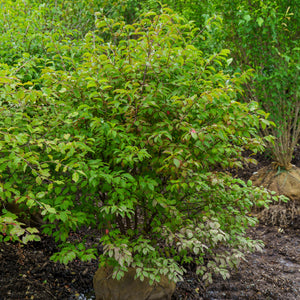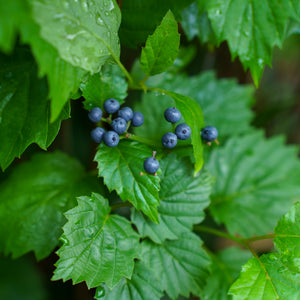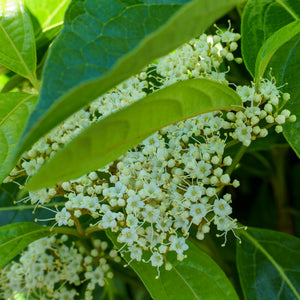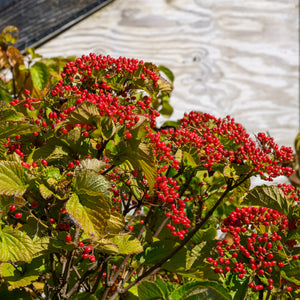The Viburnum Guide
Viburnum is a diverse and widely used group of deciduous and evergreen shrubs known for their ornamental blooms, attractive foliage, fall color, and wildlife-friendly berries. With over 150 species and countless cultivars, viburnums range from small, compact border shrubs to large, sprawling landscape specimens. Their adaptability, beauty, and functionality make them a favorite in gardens, hedgerows, and naturalistic plantings across many regions.
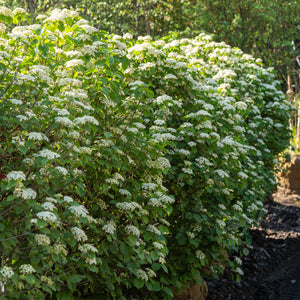
About
The Viburnum genus includes both native and non-native species, offering a wide range of forms, textures, and seasonal interest. Many species produce fragrant white or pink flowers in spring, followed by colorful berries that persist into winter and attract birds.
Popular categories include:
- Fragrant Viburnums: Viburnum carlesii ('Spice Baby', 'Spice Girl', 'Cayuga') and Viburnum × burkwoodii ('Mohawk') are known for their intensely fragrant spring blooms.
- Berry-Producing Viburnums: Viburnum dentatum ('Blue Muffin', 'Chicago Lustre') and Viburnum dilatatum ('Cardinal Candy', 'Michael Dodge') produce vibrant fruit that supports wildlife.
- Evergreen and Semi-Evergreen Viburnums: Viburnum rhytidophyllum, Viburnum × pragense, and Viburnum davidii provide year-round foliage.
- Doublefile and Japanese Snowball Viburnums: Viburnum plicatum f. tomentosum ('Shasta', 'Mariesii') and V. plicatum f. plicatum ('Popcorn') offer layered branching and dramatic flowering.
- Native Viburnums: Viburnum trilobum (American cranberrybush), Viburnum lentago (nannyberry), and Viburnum prunifolium (blackhaw) are well-suited for native gardens and wildlife habitats.
Viburnums can be used for screening, hedging, foundation plantings, and specimen displays. Their multi-season appeal and generally low maintenance needs make them invaluable additions to diverse landscape styles.
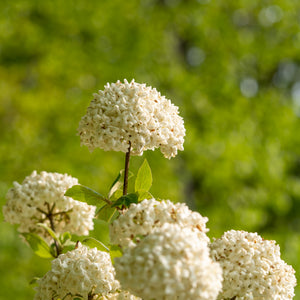
PLANTING
USDA Hardiness Zones: Most viburnums grow in Zones 4–8, with some cultivars extending into Zone 3 or Zone 9 depending on species.
Soil: Prefers well-drained, moderately fertile soils. Tolerates clay and loam. Avoid poorly drained, compacted soils.
Sunlight: Full sun to part shade. Flowering and berry production are best in full sun, but some types tolerate moderate shade.
Watering: Moderate water needs. Keep soil evenly moist during establishment. Drought tolerance increases with maturity.
Spacing: Space 3 to 12 feet apart depending on mature size and usage (hedge, screen, specimen, etc.).
Planting Time: Early spring or fall is best. Avoid planting during hot summer months to reduce transplant shock.
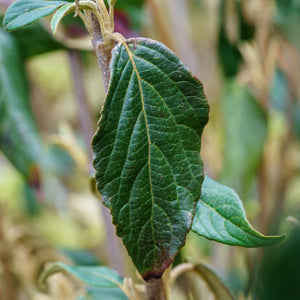
CARE
Watering: Water deeply and consistently the first year. Established plants tolerate occasional dry spells.
Fertilizing: Fertilize in early spring with a balanced, slow-release fertilizer if growth is poor or leaves are pale.
Pruning: Prune immediately after flowering for spring-blooming varieties to maintain shape and encourage flowering next season. Late summer or fall pruning can reduce bloom. Remove dead or crossing branches as needed.
Pests and Diseases: Generally pest-free. Aphids, viburnum leaf beetle, and powdery mildew may occur but are rarely severe with proper spacing and airflow.
Mulching: Apply a 2–3 inch mulch layer to conserve moisture, suppress weeds, and insulate roots.
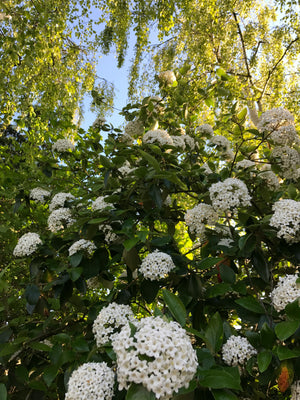
HOW TO USE
Hedges and Screens: Use dense varieties like Viburnum dentatum or Viburnum × pragense for privacy hedges or property borders.
Foundation Plantings: Compact forms such as Viburnum carlesii 'Spice Baby' or Viburnum opulus 'Compactum' work well near buildings and walkways.
Pollinator and Wildlife Gardens: Spring flowers attract pollinators, and fall berries feed birds. Combine with native plants like Amelanchier, Aronia, and Itea for a diverse habitat.
Specimen Plants: Fragrant or architectural types like Viburnum carlesii 'Spice Girl' or Viburnum plicatum 'Shasta' make excellent standalone features in lawns or garden beds.
Woodland Edges: Native viburnums such as Viburnum lentago or Viburnum prunifolium blend beautifully into naturalized settings with dogwoods and ferns.
Four-Season Borders: Combine evergreen viburnums like Viburnum rhytidophyllum 'Alleghany' with flowering shrubs and perennials for continuous interest.
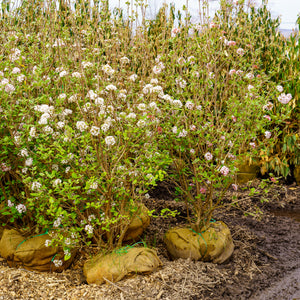
Common Questions
When to prune viburnum? Prune spring-blooming varieties right after flowering. Prune evergreen types or reblooming varieties in late winter to early spring.
When to transplant viburnum shrub? Transplant in early spring or fall. Water well before and after moving to reduce shock.
Do deer eat viburnum? Some viburnum species are deer resistant, but others may be browsed. Viburnum dentatum and Viburnum rhytidophyllum are more resistant than others.
Do rabbits eat viburnum? Rabbits may nibble young growth, especially in winter, but mature shrubs are usually avoided.
Is viburnum poisonous to cats or dogs? Most viburnums are not listed as toxic to pets, but ingestion of large quantities may cause mild digestive upset.
How fast does viburnum grow? Growth rate varies by species. Most grow moderately—12 to 24 inches per year under good conditions.
Is viburnum evergreen? Some species are evergreen or semi-evergreen, such as Viburnum rhytidophyllum and Viburnum × pragense, while others are fully deciduous.
When do viburnums bloom? Most bloom in mid to late spring, though a few varieties bloom into summer.
Do viburnum need full sun? They prefer full sun for best blooms and berries but will tolerate part shade. Shade may reduce flowering and fruiting.
Conclusion
Viburnum is one of the most valuable multi-purpose shrubs available, offering fragrance, beauty, pollinator benefits, and seasonal transitions from spring flowers to fall berries. Whether you're designing for privacy, wildlife, or aesthetics, viburnums provide a reliable, low-maintenance solution that adapts to a range of garden styles. With so many cultivars to choose from, there’s a viburnum to enhance nearly every landscape.
The Viburnum Collection
Sold Out
Sold Out
Sold Out

